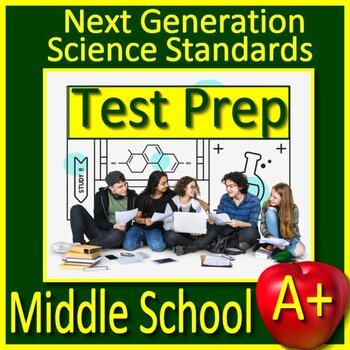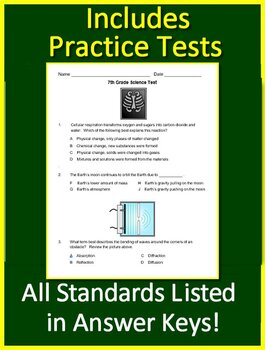Next Generation Science Test Prep Bundle Middle School NGSS SELF-GRADING GOOGLE!
- Zip
- Google Apps™
- Internet Activities

What educators are saying
Products in this Bundle (24)
showing 1-5 of 24 products
Description
Next Generation Science Test Prep: This HUGE bundle has EVERYTHING you need to cover the new Next Generation Science Standards for Middle School. ALL NGSS standards are covered using a variety of learning tasks. Perfect for test prep practice and NGSS spiral review. ALL of the practice tests are written in SELF-GRADING GOOGLE FORMS. (Printable copies also included.)
The tests are completely printable, but Self-Grading Google Form links are also provided for use in Google™ Classroom for remote learning. (4 tests with 146 test questions and answers) Perfect for distance learning (at home elearning). Students use Ipads, Chromebooks, Laptops, Desktops, etc.
The independent learning packets (14 packets with 264 questions and answers) and printable, but Google links have also been provided for paperless activities.
The games can be played competitively in school, but also can be played remotely at home for distance learning. Students can review these skills by themselves, or play with a family member or friend. They were created in PowerPoint format, and can easily be played with a PowerPoint reader. However, they can also be uploaded to Google Classroom, and opened in Google Slides for fun Google Classroom Games!
Includes:
-4 Practice Tests with 146 multiple choice NGSS standardized test questions and answers (ALL OF THESE ARE WRITTEN IN SELF-GRADING GOOGLE FORMS!)
-60 Task Cards - multiple choice NGSS questions and answers
-3 Science Game Shows - 75 questions and answers
Student Packets -
-Earth Science (3 packets - 60 Questions)
-Life Science (3 packets - 60 Questions)
-Physical Science (3 packets - 60 Questions)
-Engineering Design (3 packets - 60 Questions)
-Animal Behavior - (12 Questions)
-Mixtures and Solutions - (12 Questions)
The tests are printable .pdfs, but Google links are also provided for Google Classroom use. Both versions are included with your purchase.
The answer keys include the exact NGSS Standards, so it is super easy to tally which standards have been mastered, and which need extra attention.
The task cards can be printed on card stock, or laminated.
The games are PowerPoint, and can be edited.
Next Generation Science Standards
Thank you and good luck on the test!
Why am I qualified to write these test prep questions? Not only have I worked as a teacher for 30 years with a Highly Qualified Status, but I also have spent 15 years writing state and national assessments, such as the SATs, ACTs, and individual state assessments that align with the Common-Core standards. This includes grading, item writing, and passage writing for these assessments.
Helpful for: NECAP STEP TCAP MSP WKCE PAWS CCSS PARCC, SC Ready, Smarter Balanced, SBAC, MCA, MCAS, LEAP 2025, ITBS, TerraNova, PSSA, NC EOG, NC Ready TNReady, ILEARN, Ohio’s State Test OST, Oklahoma State Test (OSTP) IAR, NJSLA, NWEA MAP, MCAP, STAAR Science Test Prep CMAS, IAR, CAASPP, MCAS, Engage NY, ACT Aspire, Georgia Milestones, AIMS, ACT Aspire
The 26 states involved in developing the NGSS, called Lead State Partners, were Arizona, Arkansas, California, Delaware, Georgia, Illinois, Iowa, Kansas, Kentucky, Maine, Maryland, Massachusetts, Michigan, Minnesota, Montana, New Jersey, New York, North Carolina, Ohio, Oregon, Rhode Island, South Dakota, Tennessee, Vermont, Washington, and West Virginia.
6th Grade Science Test Prep
7th Grade Science Test Prep
8th Grade Science Test Prep
9th Grade Science Test Prep





